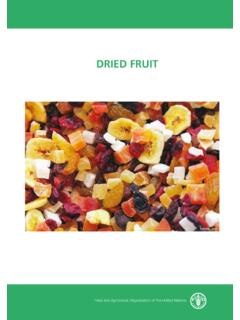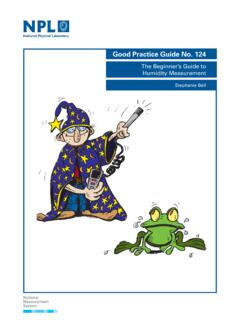Transcription of Annex 5 Supplementary guidelines on good manufacturing ...
1 215 World Health OrganizationWHO Technical Report Series, No. 961, 2011 Annex 5 Supplementary guidelines on good manufacturing practices for heating, ventilation and air-conditioning systems for non-sterile pharmaceutical dosage forms1. Introduction2. Scope of document3. Glossary4. Products and personnel Air fi ltration Unidirectional airfl ow Infi ltration Cross-contamination Displacement concept (low pressure differential, high airfl ow) Pressure differential concept (high pressure differential, low airfl ow) Physical barrier concept Temperature and relative humidity5.
2 Dust control6. Protection of the General Dust in exhaust air Vapour and fume removal7. Design of HVAC systems and General Air distribution Recirculation system Full fresh-air systems Additional system components8. Commissioning, qualifi cation and Commissioning Qualifi cation Maintenance9. PremisesReferencesFurther reading2161. IntroductionHeating, ventilation and air-conditioning (HVAC) play an important role in ensuring the manufacture of quality pharmaceutical products. A well designed HVAC system will also provide comfortable conditions for guidelines mainly focus on recommendations for systems for manufacturers of solid dosage forms.
3 The guidelines also refer to other systems or components which are not relevant to solid dosage form manufacturing plants, but which may assist in providing a comparison between the requirements for solid dosage-form plants and other system design infl uences architectural layouts with regard to items such as airlock positions, doorways and lobbies. The architectural components have an effect on room pressure differential cascades and cross-contamination control. The prevention of contamination and cross-contamination is an essential design consideration of the HVAC system. In view of these critical aspects, the design of the HVAC system should be considered at the concept design stage of a pharmaceutical manufacturing , relative humidity and ventilation should be appropriate and should not adversely affect the quality of pharmaceutical products during their manufacture and storage, or the accurate functioning of document aims to give guidance to pharmaceutical manufacturers and inspectors of pharmaceutical manufacturing facilities on the design, installation, qualifi cation and maintenance of the HVAC systems.
4 These guidelines are intended to complement those provided in Goodmanufacturing practices for pharmaceutical products (1) and should be read in conjunction with the parent guide. The additional standards addressed by the present guidelines should, therefore, be considered Supplementary to the general requirements set out in the parent Scope of documentThese guidelines focus primarily on the design and good manufacturing practices (GMP) requirements for HVAC systems for facilities for the manufacture of solid dosage forms. Most of the system design principles for facilities manufacturing solid dosage forms also apply to other facilities such as those manufacturing liquids, creams and ointments.
5 These guidelines do not cover requirements for manufacturing sites for the production of sterile pharmaceutical products. These guidelines do not cover the specifi c requirements relating to facilities handling hazardous products. guidelines for hazardous product facilities are covered in a separate WHO guidelines are intended as a basic guide for use by pharmaceutical manufacturers and GMP are not intended to be prescriptive in specifying requirements and design parameters. There are many parameters affecting a clean area condition and it is, therefore, diffi cult to lay down the specifi c requirements for one particular parameter in pharmaceutical manufacturers have their own engineering design and qualifi cation standards and requirements may vary from one manufacturer to the next.
6 Design parameters and user requirements should, therefore, be set realistically for each project, with a view to creating a cost-effective design, yet still complying with all regulatory standards and ensuring that product quality and safety are not compromised. The three primary aspects addressed in this manual are the roles that the HVAC system plays in product protection, personnel protection and environmental protection (Figure 1).Cognisance should be taken of the products to be manufactured when establishing system design parameters. A facility manufacturing multiple different products may have more stringent design parameters with respect to cross-contamination control, compared with a single product 1 The guidelines address the various system criteria according to the sequence set out in this diagram2183.
7 GlossaryThe defi nitions given below apply to terms used in these guidelines . They may have different meanings in other criteriaMeasurable terms under which a test result will be considered limitThe action limit is reached when the acceptance criteria of a critical parameter have been exceeded. Results outside these limits will require specifi ed action and changes per hour (ACPH)The volume of air supplied to a room, in m3/hr, divided by the room volume, in unit (AHU)The air-handling unit serves to condition the air and provide the required air movement within a enclosed space with two or more doors, which is interposed between two or more rooms, of differing classes of cleanliness, for the purpose of controlling the airfl ow between those rooms when they need to be entered.
8 An airlock is designed for and used by either people or goods (PAL, personnel airlock; MAL, material airlock).alert limitThe alert limit is reached when the normal operating range of a critical parameter has been exceeded, indicating that corrective measures may need to be taken to prevent the action limit being where the installation is complete with all services connected and functioning but with no production equipment, materials or personnel where the installation is complete with equipment installed and operating in a manner agreed upon by the customer and supplier, but with no personnel air-conditioning unit (see air-handling unit)
9 Change controlA formal system by which qualifi ed representatives of appropriate disciplines review proposed or actual changes that might affect a validated 219status. The intent is to determine the need for action that would ensure that the system is maintained in a validated area (cleanroom)18An area (or room or zone) with defi ned environmental control of particulate and microbial contamination, constructed and used in such a way as to reduce the introduction, generation and retention of contaminants within the systemA system where the product or material is not exposed to the manufacturing is the documented process of verifying that the equipment and systems are installed according to specifi cations, placing the equipment into active service and verifying its proper action.
10 Commissioning takes place at the conclusion of project construction but prior to process or device to contain product, dust or contaminants in one zone, preventing it from escaping to another undesired introduction of impurities of a chemical or microbial nature, or of foreign matter, into or on to a starting material or intermediate, during production, sampling, packaging or repackaging, storage or areaAn area within the facility in which specifi c environmental facility conditions and procedures are defi ned, controlled, and monitored to prevent degradation or cross-contamination of the parameter or componentA processing parameter (such as temperature or relative humidity ) that affects the quality of a product, or a component that may have a direct impact on the quality of the quality attribute (CQA)A physical, chemical, biological or microbiological property or characteristic that should be within an appropriate limit, range or distribution to ensure the desired product.













